Unit
3:
Land-Based
Empires
(1450–1750)
-
Chapters
12
and
13
Ch.
12:
The
Worlds
of
the
15th
Century
The
Shapes
of
Human
Communities
●
there
were
many
different
ways
to
organize
human
life
-
pastoralist
societies,
hunter-gatherer
groups,
agricultural
societies,
states
and
empires.
Paleolithic
Persistence:
Australia
and
North
America
●
historians
call
hunter-gatherer
societies
Paleolithic
or
old
stone
age
peoples
●
these
peoples
progressed
over
time
thru
interaction
with
their
agriculturalist
neighbors
●
in
Australia,
hunter
gatherer
groups
traded
with
each
other,
took
materials
or
practices
from
outsiders,
but
did
not
adopt
their
agriculture.
they
mastered
their
environment
with
firestick
farming
which
involved
setting
fires
to
clear
the
land,
making
hunting
easier
and
letting
certain
plants
and
animals
thrive.
●
in
North
America,
“complex”
hunter
gatherer
societies
formed
because
of
an
abundance
of
fish
and
animals.
they
had
permanent
village
settlements,
economic
specialization,
chiefdoms
and
powerful
leaders,
social
hierarchies,
and
food
storages
●
with
the
agricultural
revolution,
hunter-gatherer
societies
for
the
most
part
died
out
Agricultural
Village
Societies:
The
Igbo
and
the
Iroquois
●
the
Igbo
peoples
lived
east
of
the
Niger
River
in
the
forests
of
West
Africa.
despite
having
a
dense
population
and
vast
trading
networks,
they
did
not
build
a
state
and
instead
stayed
in
small
village-based
societies,
using
titles
or
associations
to
keep
order.
●
in
present
day
New
York,
the
Iroquois-speaking
ppls
adopted
the
3
sisters
from
Mesoamerica
and
distinct
ppls
emerged
as
the
population
grew.
these
ppl
fought
frequently,
and
their
fighting
led
to
an
alliance
of
5
Iroquois-speaking
ppls
or
the
Five
Nations
-
the
Mohawk,
Oneida,
Onondaga,
Cayuga,
and
Seneca.
○
this
league
brought
clan
leaders
together
and
suppressed
conflicts
w/
a
consensus,
allowing
each
party
to
express
their
values.
in
this
society,
women
could
select
leaders
and
control
agriculture
and
property.
○
Ben
Franklin
used
some
Iroquois
practices
in
his
gov’t:
separation
of
powers,
checks
and
balances,
and
the
representative
government
Pastoral
Peoples:
Central
Asia
and
West
Africa
●
as
the
Mongol
Empire
disintegrated,
the
Turkic
warrior
Timur
led
attempts
to
restore
it.
he
retook
Russia,
Persia,
and
India,
but
fighting
among
his
successors
prevented
a
lasting
empire.
this
conquest
was
last
great
military
success
of
pastoralists
●
West
Africa's
largest
pastoral
society,
the
Fulbe,
lived
in
small
communities
and
paid
agricultural
peoples
so
their
herds
could
graze
in
their
fields.
they
adopted
Islam
and
helped
it
spread
through
uprisings
or
jihads.
Civilizations
of
the
15th
Century:
Comparing
China
and
Europe
Ming
Dynasty
China
●
founded
by
Zhu
Yuanzhang,
the
leader
of
the
White
Lotus
Society
●
the
Ming
Dynasty
worked
to
eliminate
all
signs
of
foreign
rule
and
focused
on
getting
back
to
the
glory
of
the
previous
Han,
Tang,
and
Song
dynasties.
○
they
re-established
the
civil
service
exam
and
centralized
government;
rebuilt
canals,
reservoirs,
irrigation;
cultivated
millions
of
acres
and
planted
many
trees
●
under
Emperor
Yongle,
the
Ming
undertook
large
and
impressive
maritime
expeditions
-
fleets
of
hundreds
of
ships
and
thousands
of
crew
members.
their
goal
was
to
enroll
1 / 2
distant
peoples
and
states
into
the
Chinese
tribute
system,
establish
power
and
prestige
in
the
Indian
Ocean,
and
exert
control
over
foreign
trade
○
ended
abruptly
and
deliberately
in
1433
since
it
was
believed
these
expeditions
were
a
waste
of
resources
for
the
self-sufficient
“middle
kingdom”
European
Comparisons:
State
Building
and
Cultural
Renewal
●
after
escaping
Mongol
conquest
but
being
devastated
by
the
plague,
Western
Europe
regrew
its
population
in
the
late
15th
century.
●
unlike
China,
who
was
able
to
maintain
a
centralized
government,
Western
Europe’s
independent
and
rival
feudal
states
divided
them.
but
these
states
learned
to
efficiently
tax
their
citizens,
create
effective
gov’t
structures,
and
raise
standing
armies.
●
the
Renaissance
was
the
“rebirth”
of
the
classic
Greco-Roman
tradition
○
similar
to
Confucianism’s
revival
in
Ming
China.
○
came
from
a
questioning
of
faith
from
the
Black
Death
○
represented
the
move
from
religion
to
the
humanities
-
art
depicted
contemporary
figures,
scholars
reflected
on
grammar,
history,
poetry
etc.
○
capturing
human
qualities
and
the
natural
world
was
preferred
over
exploring
religious
truths.
still,
humanities
complemented
religion,
they
didn’t
replaced
it.
European
Comparisons:
Maritime
Voyaging
●
like
the
Chinese,
Europeans
also
launched
outward
maritime
expeditions
○
they
were
initiated
in
1415
by
Portugal,
who
sailed
down
Africa's
west
coast.
○
in
1492,
Christopher
Columbus,
who
was
funded
by
Spain,
ran
into
the
Americas.
●
there
were
differences
in
the
size,
motivation,
and
method
of
both
nations’
voyages
○
European
fleets
couldn't
even
compare
to
the
size
of
Chinese
fleets
○
Europeans
were
motivated
by
mercantilism
and
the
desire
for
Christian
convert,
but
China
wanted
more
tribute
states
and
reputation
for
themselves
■
mercantilism:
the
idea
that
wealth
was
measured
in
reserves
of
natural
resources
and
the
profit
from
exporting
more
than
importing.
○
Europe
used
violence
to
make
trade
relationships,
China
was
peaceful
●
China’s
withdrawal
from
the
Indian
Ocean
signaled
the
European
entry.
●
China
could
end
their
maritime
expeditions
because
of
their
centralized
government,
but
the
rival
states
of
Europe
couldn’t
unite
and
put
an
end
to
the
expeditions.
Civilizations
of
the
Fifteenth
Century:
The
Islamic
World
●
the
most
notable
change
that
the
world
of
Islam
experienced
in
the
15th
and
16th
centuries
was
the
fragmentation
of
Islamic
civilization
into
4
empires.
○
these
empires
brought
political
coherence,
military
power,
economic
prosperity,
and
cultural
brilliance
to
the
Islamic
world.
this
2nd
flowering
drove
Islam’s
spread
to
new
regions.
In
the
Islamic
Heartland:
The
Ottoman
and
Safavid
Empires
●
the
Ottoman
Empire
was
the
most
impressive
and
enduring
of
the
new
Islamic
states
because
of
its
huge
territory,
long
duration,
incorporation
of
diverse
peoples,
and
its
economic
and
cultural
sophistication.
●
the
seizure
of
Constantinople
in
1453
let
Turkic
invaders
recognize
themselves
as
successors
to
the
Roman
empire,
and
opened
the
way
to
further
expansion
in
Europe.
renewed
the
Islamic
worlds
unity
and
represented
the
Turks’
emergence
as
dominators
of
the
Islamic
world
through
serving
as
the
“strong
sword
of
Islam”
●
in
Persian
lands
east
of
the
Ottoman
Empire,
the
Safavid
empire
was
taking
shape.
it
emerged
from
a
Sufi
order
founded
by
Safi
al-Din,
and
imposed
Shia
Islam
officially.Powered by TCPDF (www.tcpdf.org)
2 / 2













